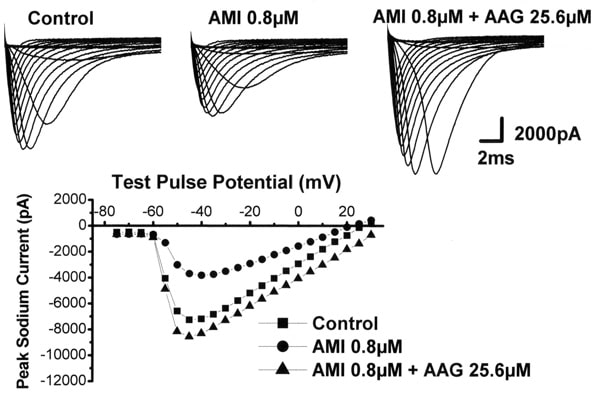α1-acid glycoprotein (AAG) is an acute phase protein whose plasma concentration increases in response to trauma, inflammation and bacterial infection (Fournier et al. 2000). We have previously reported that AAG reverses the sodium channel blockade induced by amitriptyline, a tricyclic antidepressant, and by quinidine, a class I antiarrhythmic agent (Ma & Henry 2001), and by cocaine (Ma et al. 2006), but AAG alone has no effect on sodium channels when the cells were bathed in physiological solution. Here we report a further discovery that AAG enhances sodium channel activation in cardiac myocytes placed in modified physiological solution with extracellular Na+ reduced to 18mM from 138mM, and with the calcium and potassium currents blocked by Cd2+ and Cs+. Under these conditions the cardiac myocytes were unable to function normally, such as generating action potentials, and the homeostasis of Na+ and other ions, and the normal physiological functions of Na+ transporters were severely disturbed (Pieske et al. 2003; Bers et al. 2003). We therefore use the term “stressed cardiac myocytes” to describe these cells, and the term “cytoprotective” to describe the enhancement of sodium channel activation by AAG. Voltage gated sodium current (INa) was recorded using whole cell patch clamp techniques to evaluate the effect of AAG. Guinea pig cardiac ventricular myocytes were isolated by enzymic digestion and continuously perfused at room temperature with normal or modified physiological solution. With extracellular Na+ reduced to 18mM, AAG 25.6μM not only reversed the INa blockade induced by 0.8μM amitriptyline, but also increased the current beyond the control level (Fig1): with control as 1, blockade was 0.46±0.21, and the reversal effect of AAG was 1.39±0.25 (N=4). When recordings were carried out in physiological solutions with 138mM extracellular Na+, cells generated action potential(AP) under current clamp, and AAG reversed the effects of amitriptyline on AP to control level, but not beyond. We conclude, therefore, that AAG may protect cardiac myocytes from physiological or pathological stress, and that this may have clinical significance.
Life Sciences 2007 (2007) Proc Life Sciences, PC339
Poster Communications: α1-acid glycoprotein enhances sodium channel activation in stressed cardiac myocytes
Y. Ma2, 1, N. S. Peters2, J. A. Henry2
1. Pharmacology, School of Pharmacy, University of Reading, Reading, United Kingdom. 2. National Heart & Lung Institute, Imperial College London, London, United Kingdom.
View other abstracts by:
Fig1. The effect of amitriptyline and amitriptyline (AMI) plus AAG on sodium channels recorded in modified physiological solution. INa was elicited by a 20 ms depolarisation to test potentials between -75mV and 30mV from a potential of -90mV. INa under control AMI and AMI plus AAG are shown in the top panel. The peak value of the currents is plotted against the test pulse potentials below. The keys indicate drug concentrations applied.
Where applicable, experiments conform with Society ethical requirements.

